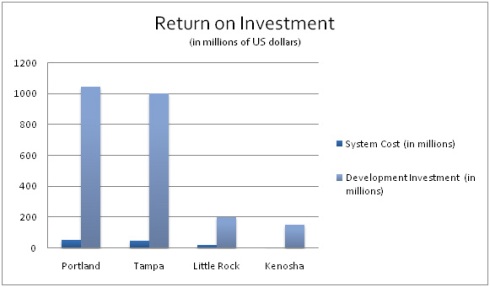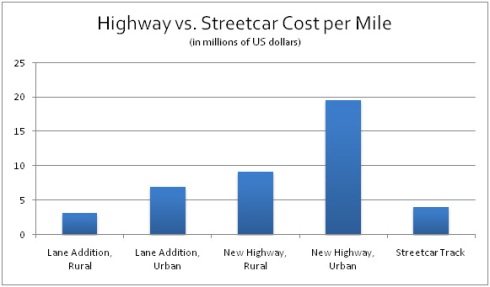In recent years, rail transport has been picked up once again as a desirable transportation choice by a country fed up with high gas prices and spending most of their lives commuting across the suburban wasteland. Mass transit saw astounding ridership numbers during pre-recession $4 per gallon gasoline prices, and during the tough economic times to follow those numbers have remained steady as commuters look to trim their household transportation budgets, even with gas dipping back below $3. The need for streetcars in many cities has emerged as a way to promote economic growth and downtown revitalization while providing more transit options. Even some conservative editorialists, usually against public transit expenditures, are expounding on the need for streetcars to return life and vitality to city streets.
Lower CO2 Emissions
The most obvious benefit of streetcars over automobiles and buses is that they run on electricity, which can be generated from clean, renewable sources. Even streetcars that run on electricity generated by coal burning power plants use that energy more efficiently than cars or buses utilize the energy stored in gasoline. In the world of ever decreasing oil supplies, this makes streetcars a more resilient transportation system that can operate on any energy source, transmitted through the medium of electric power.
Lower Cost Per Trip
Maintaining a family “fleet” of vehicles is not cost effective, especially in the present reality of ever-increasing gas prices and ever-scarcer oil. Travel by diesel bus is even cheaper than a hybrid automobile, and streetcars reduce that cost further. Streetcars are based on the simple technology of electric traction, and are built with parts that can last decades and require little maintenance. Streetcars have a cheaper lifetime cost because they lack tires, oils, fluids, and fragile parts that need constant replacement.
Streetcars as Urban Investment

Source: Street Smart: Streetcars and Cities in the Twenty-First Century, edited by Gloria Ohland and Shelley Poticha, Reconnecting America
By far the most important reason cities around the United States are looking at implementing streetcar systems is their ability to spur development and densification. Portland, Oregon was the first system built in recent years that has produced major real estate investment in the areas it serves, and it is the model upon which systems in Tampa and Little Rock were based. The most astounding example is Kenosha, Wisconsin. Due to its very low construction cost of $4 million, the $150 million in lakefront development the line created was the largest percentage of return on investment seen in any streetcar system construction to date.
Track Cost per Mile
The cost of building streetcar systems has varied widely from city to city, and is affected by several factors, including land values, style of infrastructure used (light rail or true streetcar) and the extent of additional street improvements that get folded into streetcar proposals.
Currently, Kenosha has the distinction of being the cheapest system constructed to date, providing an example of what is possible for a small city of 90,000 to accomplish with rail transit solutions. Kenosha managed to keep costs down by using restored secondhand vintage cars, doing a minimal amount of modifications to the streetscape, and using true light-duty streetcar infrastructure.
$4 million per mile may still seem too expensive for Springfield taxpayers, but when compared with the cost per mile of lane additions and new highways to meet growing traffic, streetcars begin to emerge as a very sensible option.





One Response to “Streetcar Economics”